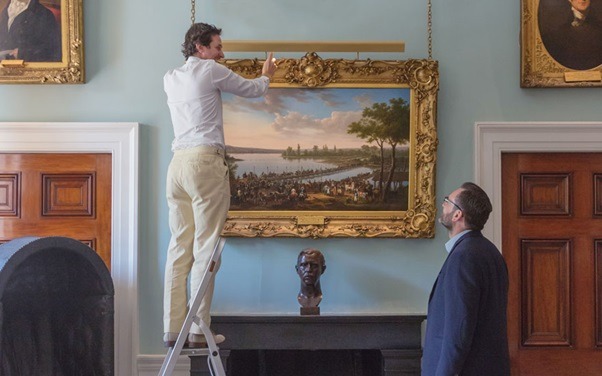Wall art lighting in galleries, museums and other places where works of art are exhibited requires special attention to both the type of light used and its placement. Everyone knows what a significant role exhibit lights play in the mastery of art – it can perhaps be called the main factor in the success of paintings after the talent of the artist himself. While natural light is the best choice, it can unfortunately not always be exploited.
Creative people work without sleep and rest, not only from dawn to dusk, but almost around the clock. Thus, it becomes obvious that at a certain stage, artificial lighting should harmoniously replace sunlight, preserving the perception of colors and shapes on the canvas. With the help of special lighting for gallery, the presentation and appearance of exhibited works can be improved. In addition, objects that the artist transfers to the canvas should be illuminated from the same angles – be it fruits with vases or facial features of sitters.
Exhibition lighting: formation of a light pattern
Unlike most ordinary people who are ready to leave certain tolerances in lighting without pretensions, artists cannot afford such a luxury. In their sphere, each relaxation of the rules is fraught with a significant decrease in the quality of work, so the requirements for setting up the gallery lighting systems are very strict. When equipping the workshop, it’s beneficial to follow these recommendations:
- first of all, there is a need to determine the natural light pattern in the room – taking into account the direction of the light, the time of year and the location of the building relative to shading objects;
- then wall art lighting is selected, which is equipped with shades that can provide the required balance between dispersion and light directivity;
- after that, empirically, exhibit lights are chosen for being used when working on the next canvas – according to their brightness, scattering angles, color rendering level and, of course, color temperature.
Light in the workshop should neither be too much nor too little. It is important to place lighting devices and supply power to them in such a way that they can be turned on individually or in small groups. This will allow the customer to smoothly switch from natural to artificial lighting with the advent of twilight without significant losses in the overall light pattern. Overexposure for painters is no better than insufficient lighting, and therefore only a well-built, dynamic and balanced lighting for wall artwork can become truly effective in this field.
How to choose gallery lighting systems?
As the sources of light direction, you can use not only ceiling models, but also wall art lighting. Such devices provide additional mobility of lighting and flexibility in its reconfiguration when changing exposure. Most of these products are equipped with a turn function, which makes it possible to set the exact angles of the glow. In addition, lighting for wall artwork creates local lighting using a LED lamp that protects the eyes from annoying reflection of light by paper.
A wide range of exhibition lighting products in Australia, together with their extensive knowledge and experience in art lighting, allows the company to provide the right solution for every project. They carefully consider the light sources to be used (in terms of color temperature, color rendering and energy savings) and luminaires that combine the demand for light distribution with an appropriate appearance. Lighting for gallery solutions also makes it easy and timely to reconfigure the angle thanks to the flexibility of hanging systems, allowing the customer to functionally change lighting with minimal effort!
If you are interested in learning art, enrolling in an art workshop can be a good idea. For more information, read our post on what to expect when you take an art workshop.

